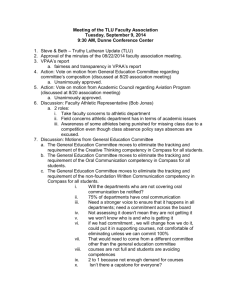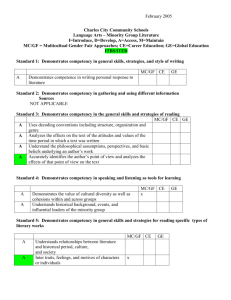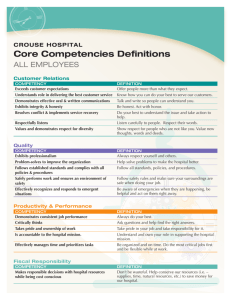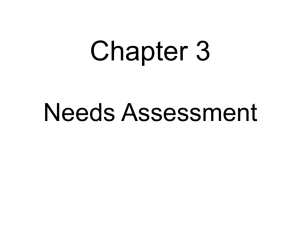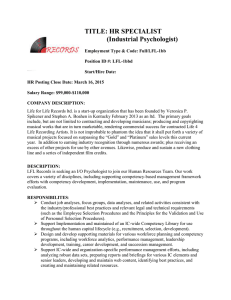COMPETENCY TESTING FOR ATHLETIC TRAINING by
advertisement
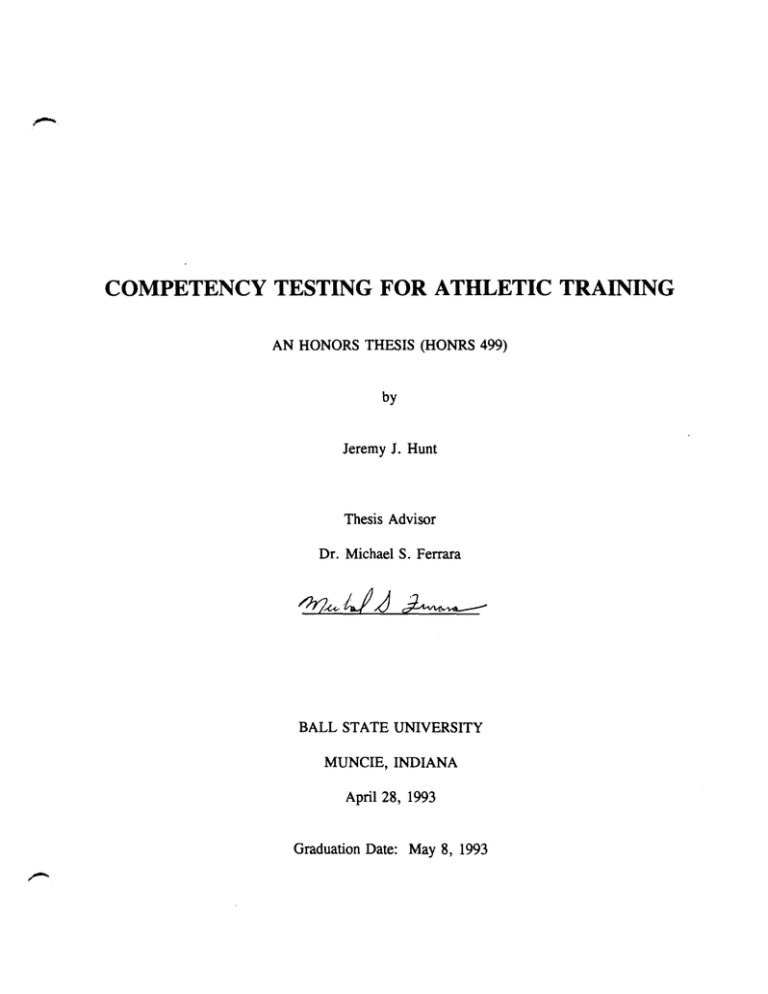
COMPETENCY TESTING FOR ATHLETIC TRAINING AN HONORS THESIS (HONRS 499) by Jeremy J. Hunt Thesis Advisor Dr. Michael S. Ferrara BALL STATE UNIVERSITY MUNCIE, INDIANA April 28, 1993 Graduation Date: May 8, 1993 speDl1 -rhe0!:.7 t, l) ;9.151 .1-4 1993 .H'U~ ABSTRACT: This is a series of competency tests based on the basic competencies of athletic training required by the National Athletic Trainers' Association. The competency tests evaluate psychomotor skills in each of the six domains of athletic training. These domains are prevention, recognition and evaluation, management/treatment and disposition, rehabilitation, organization and administration, and education and counseling. The competency tests have been divided into four groups, each group representing a year in the athletic training curriculum. The tests that were included in each year correspond to the normal course work and clinical experience of an athletic training student at that point in their professional education. Each of the four sections, Freshman, Sophomore, Junior, and Senior, begins with a list of psycomotor competencies from each domain to be learned in that year. Following this list are the tests that will be used to evaluate a student's competency in each skill listed. RATIONALE This project was undertaken to fill a void in the athletic training curriculum at Ball State University. There was a need to determine if athletic trainers were indeed learning to perform certain skills adequately as they progressed through the athletic training program. The ultimate goal of the athletic training curriculum at Ball State is to prepare students to pass the National Athletic Trainer's Association certification examination. This examination consists of written, oral/practical, and written simulation tests. Testing competency in psychomotor skills provides a good indication of how well a student is prepared to complete the examination, especially the oral/practical portion. Therefore, the purpose of this project was to develop competency based skills tests for the athletic trainer. The skills tested were based on a booklet published by the National Athletic Trainer's Association called Competencies in Athletic Training. This booklet outlines the primary tasks performed by the entry-level athletic trainer. These tasks were established through the role delineation study conducted by the National Athletic Trainer's Association Board of Certification in 1989 to establish and validate appropriate content areas for the certification examination. Each skill was assigned to be year. test~d dl'.ring a certain The assignments were intended to correspond to course material that would be learned in class, thereby creating practical application of material from the classroom in the athletic training room. The skills tests were written in a checklist format since this is the best method for an evaluator to use while someone is explaining and demonstrating a task. The test forms were designed not only to be tools of evaluation, but also tools of education. Information not necessary for an evaluator, but helpful to the student was usually included on each form, normally in parentheses. Consequently, the test forms can also be used as a study guide and future reference for the students. The skills as they were stated in Competencies in Athletic Training were very broad based, which presented some problems. If the skills were to be thoroughly tested, one would have to test that skill in every applicable situation. Taping and bracing skills, for example, would require a separate test for each joint of the body. Although this approach to testing competency would be thorough, it would also be impractical. Therefore, when these situations arose, those situations where the skill was used most were chosen to be evaluated. By doing this, basic competency in the skill can be determined, and one can assume that these skills could be carried over into other situations. The only skills that were not tested for the most common situation only were those in the category of recognition and evaluation for the Junior year. These skills were tested for every joint of the body due to the fact that specific knowledge of each joint's structure and function is necessary for a complete evaluation. It cannot be assumed that competency in evaluating one joint carries over to the evaluation of other joints. The repetition of some skills form lower levels to higher levels posed problems as well. When this occurred, the competency was usually covered in greater depth in the advanced level. A good example of this is the use of an isokinetic machine, the CYBEX 6000. This competency tested in the Sophomore year involves patient set up and preparation. In the Junior year, however, a student must be able to set someone up on the CYBEX, interpret the data collected, and make the proper exercise recommendations. Now that these competency tests have been developed, the next task is to assure that each one of these psychomotor skills is learned. This can be accomplished through the utilization of the competency tests in labs or through the creation of a Competencies in Athletic Training class. This class could be taught by the Seniors in the athletic training program to demonstrate their competency in education and counseling. Hopefully, this thesis is only the beginning of the athletic training competency testing program at Ball State University. It is a tool that will need to be evaluated and revised yearly as the needs of the students and the profession of athletic training change and evolve. FRESHMAN COMPETENCIES Domain I: Prevention 1. Use of commercial fitness testing equipment, administration of standard physical fitness tests, and recording and interpretation of test results. 2. Collection and interpretation of climatic data (temperature, humidity) through the use of appropriate instruments (sling psychrometer, WGBT Index, etc.). Domain II: 1. Recognition and Evaluation Construction and phrasing of questions appropriate to obtaining a medical history of an injured/ill athlete including a past history and a history of the present injury/illness. Domain III: Management/Treatment and Disposition 1. Application of first aid procedures for closed soft tissue injuries including the use of pressure bandages, ice, and elevation. 2. Control of external bleeding including application of direct pressure, arterial pressure, and application of dressings and bandages. 3. Application of aseptic techniques in the management of open wounds (sterilization procedures, wound cleansing/debridement, dressing and bandaging, etc.). 4. Performance of cardiopulmonary resuscitation (CPR) techniques according to current standards, including assessment of level of consciousness and vital signs and identification and removal of airway obstructions due to anatomical or mechanical causes. Domain IV: 1. Rehabilitation Anthropometric measurement including girth measurement, skinfold measurement, underwater weighing, limb length measurement, height, weight etc. COMMERCIAL FITNESS TESTING EQUIPMENT: THE CYBEX FITRON - Please check off as student explains and demonstrates the proper set up and use of the Cybex Fitron cycle ergometer. Adjusts seat height so that there is approximately a 10 degree flexion of the knee when the pedal is in its lowest position. Adjusts handle bars to assume a slight forward leaning of the body without causing too much weightbearing by the arms. Makes sure that the person has ball of foot over the center of the pedal. Adjusts toe straps to desired tightness. Selects proper pedal speed in revolutions per minute. Sets timer to desired workout time. Instructs person on desired workload to be maintained. Advises person to warm up and cool down 2 to 5 minutes. Monitors heart rate during exercise to determine if person is exercising in their target heart rate zone (220-age x 70-80%=THR zone). Is able to estimate persons fitness level from heart rate maintained and their ability to recover. COMMERCIAL FITNESS TESTING EQUIPMENT: THE CYBEX UBE - Please check off as the student explains and demonstrates proper set up and use of the Cybex Upper Body Exercise Ergometer (UBE). Adjusts seat height so that axis of arm crank is at same- level as axi s of shoulder. Adjusts seat distance to comfortable distance, making sure trunk of person does not lean more than slightly forward during exercise. Adjusts arm crank so that arms go to nearly full extension during rotation. Instructs person on proper way to grip handles. Instructs person to move crank in a smooth and rhythmic motion. Sets crank speed knob at the desired revolutions per minute. Sets timer for desired duration of exercise. Informs person of desired work rate to be maintained. Advises person to warm up and cool down for 2 to 5 minuets at lower work rate. Monitors heart rate during exercise to see if person is in their target heart rate zone (220-age x 70-80%=THR). Is able to estimate persons fitness level from heart rate maintained and their ability to recover. COLLECTING AND INTERPRETING CLIMACTIC DATA -As the student demonstrates competency in operating a sling psychrometer and interpreting its data, please check off the following: Wets the string on the wet bulb. Rotates the sling psychrometer at the proper speed and for the proper duration. Identifies the wet bulb temperature. Identifies the dry bulb temperature. Aligns two temperatures on slide rule of psychrometer and determines relative humidity. Makes proper recommendation for practice in accordance with the data collected. **Evaluator may now present hypothetical situations of temperature and humidity and ask student what procedure they would take. possible situations: Temperature Humidity Correct Procedure 1. 80-90 F under 70% Watch athletes that are slightly overweight 2• 80-90 F over 70% 90-100 F under 70% Athletes should take a ten minute rest and water break ever hour. All athletes should be under constant, careful supervision. 90-100 F over 70% 3. over 100 F Ideally it would be well to suspend practice or conduct a shortened practice in shirts and shorts. Reference Arnheim, Daniel D. (1989). Modern principles of athletic training. St. Louis: Times Mirror/Mosby. OBTAINING A MEDICAL HISTORY 1. Present student with an injury situation and ask him or her to obtain a brief medical history from you. 2. Please check off as the student demonstrates competency in obtaining a medical history by asking questions concerning the following: Location of pain; chief complaints Previous history of injury and treatment to this area. Type and severity of pain Onset of pain; what caused it- mechanism. Sounds heard (snap or pop). Numbness or tingling. What situations/activities increase pain. What situations/activities relieve pain. FIRST AID PROCEDURES: CLOSED SOFT TISSUE INJURIES 1. Give student a situation involving an acute closed soft tissue injury (contusion, sprain, strain). 2. Please check off as student demonstrates competency in dealing with closed soft tissue injuries by explaining and demonstrating the following: Identifies area of injury through observation and palpation. Obtains enough ice to cover the entire area of inflamation. Wraps the ice on tightly with an ace bandage, covering the entire area of injury. If possible, positions athlete so that they are comfortable and injured area is elevated above the level of the heart. Instructs athlete on duration of treatment (ie. 20 min. for ice packs). If applicable, applies compression bandage in proper manner (ie. for ankle sprain wraps from toes to mid-calf with no gaps) after ice treatment. FIRST AID PROCEDURES: OPEN WOUNDS 1. Present student with one or more situations involving an open wound. Choose from abrasion, laceration, incision, puncture, avulsion, and amputation. 2. Please check off as student demonstrates competency in dealing with open wounds by explaining and demonstrating the following: Washes hands and/or puts on latex gloves. Controls bleeding by: Direct pressure Arterial pressure* Both* Checks sensation and motor ability if nerve or tendon damage is suspected.* Inspects wound to determine if medical attention (ie. stitches, puncture, etc.) is required. Removes all dirt and debris by scrubbing wound with betadine scrub or soap and water. Cleans with a circular pattern; doesn't wipe toward wound. Cleans wound with an antiseptic (betadine solution, ioprep, alcohol, etc). Applies steri-strips, butterfly stitches* Covers wound with proper dressing (band-aid, sterile gauze bandage). Stabilizes impaled object* Cleans amputated part.* Wraps amputated part in wet gauze or towel.* Places amputated part in plastic bag and places on ice.* *If applicable for situation presented. CARDIOPULMONARY RESUSCITATION ** Student must produce proof of competency in adult or community CPR by presenting a copy of his/her valid CPR card. Affix copy of card to this page. ANTHROPOMETRIC MEASUREMENTS: HEIGHT, WEIGHT, BODY FAT 1. Ask student to demonstrate the proper procedure to weigh someone on a scale, measure their height, and determine their body fat percentage through the use of skinfold calipers. 2. Please check off as student demonstrates competency in taking these anthropometric measurements by explaining and demonstrating the following: Able to balance the scale as person being weighed stands on it. Has person stand with proper posture when measuring height. converts height measurement into feet and inches. Takes skinfold measurements from the right side of the body. Grasps a fold of skin and subcutaneous fat without the underlying muscle tissue. Places caliper perpendicular to the fold, approximately 1 cm from the thumb and forefinger holding the skinfold. Takes skinfold measurements at the proper sites according to the gender of the person being measured, and the body fat percentage equation chosen by the evaluator. possible sites include: (check those appropriate for situation) triceps subscapular suprailiac abdominal anterior thigh Is able to plug measurements taken into the chosen equation and determine body fat percentage. SOPHOMORE COMPETENCIES Domain I: Prevention 1. Operation of contemporary isokinetic, isotonic, and isometric strength testing devices. 2. Administration of anthropometric measurement techniques (skinfold measurement, underwater weighing, girth measurement, limb length measurement, height, weight, etc.) and other appropriate physical examination/ screening procedures (blood pressure, pulse, etc.). 3. Selection and fitting of standard protective equipment and clothing consistent with the physical characteristics and needs of the individual athletes and the demands of the participation in specific sports activities. 4. Selection, fabrication, and application of appropriate preventative taping and wrappings, splints, braces, and other special protective devices consistent with sound anatomical and biomechanical principles. Domain II: 1. Recognition and Evaluation Assessment of blood pressure through the use of sphygmomanometer and evaluation of pulse rate, strength, and regularity. Domain III: Management/Treatment and Disposition 1. Application of immobilization devices including cervical collars, spine boards, fixation and traction splints, shoulder immobilizers, slings, etc. 2. Use of short distance transportation methods including walking assists, manual carries, transfers from ground/ floor to stretcher/spine board, and stretcher carries. 3. Performance of cardiopulmonary resuscitation (CPR) techniques according to current standards, including assessment of level of consciousness and vital signs and identification and removal of airway obstructions due to anatomical or mechanical causes. Domain IV: Rehabilitation 1. Measurement of range-of-motion for all major joints of the body through the use of a goniometer and other commonly used techniques. 2. Measurement and fitting of ambulation aids and instruction in the use of common crutch/cane gaits. 3. Application of special protective devices (braces, splints, special pads, etc.) and taping, bandaging, and wrapping procedures. OPERATION OF ISOKINETIC TESTING DEVICES: THE CYBEX 6000 1. Ask student to set you up on the Cybex for a knee flexion/extension exercise bout, and then a shoulder internal rotation/external rotation modified exercise bout. 2. Please check off as the student explains and demonstrates the following: KNEE: EXTENSION/FLEXION Enters clients name and social security number. Enters personal data Chooses correct DAP code (Knee Ext/Flex). Chooses which side to exercise. Chooses action type Concentric/Concentric. Chooses a facility protocol. Rotates dynamometer to appropriate side. Installs long or short adjustable arm in dynamometer input tube. Positions client on appropriate positioning chair. Adjusts seat back tilt to comfortable position. Adjusts seat back to client. Adjusts dynamometer height to knee axis. (Knee axis is a line passing through the femoral condyles.) Adjusts dynamometer axis fore/aft to knee axis. Positions shin pad on distal aspect of tibia by adjusting length position of adjustable arm. Stabilizes the client with seat belt and velcro straps. Sets anatomical zero. Seeks full extension and sets mechanical stop in proper position. Seeks flexion (-90-100) and sets mechanical stop in proper position. Instructs client to begin test in full flexion. SHOULDER: INTERNAL/EXTERNAL ROTATION MODIFIED Enters clients name and social security number. Enters clients personal data. Chooses side to be exercised. Chooses correct DAP code (IR/ER modified). Chooses action type concentric/concentric. Chooses a facility protocol. Tilts dynamometer head back to 70 degrees and faces it forward. Inserts wrist shoulder adapter. Affixes elbow stabilization pad. Sets handgrip to shoulder IR/ER position. Postions client in standing with elbow flexed to 90 degrees and shoulder slightly abducted. Adjusts dynamometer height so that shoulder is at normal level and client is able to stand up straight. Stabilizes forearm in elbow stabilization pad with velcro strap. Seeks correct anatomical zero position. Seeks internal rotation and sets mechanical stop in the proper position. Seeks external rotation and sets mechanical stop in the proper position. Instructs client to begin exercise in full external rotation. SCREENING PROCEDURES: PULSE RATE/BLOOD PRESSURE - Ask student to demonstrate competency in the assessment of pulse rate and blood pressure. Please check off as the student explains and demonstrates the following: Is able to locate either radial or carotid pulse. Calculates pulse rate in beats per minute by counting beats for 15 seconds and multiplying by four. Analyzes pulse in terms of strength and regularity. Applies sphygmomanometer in proper manner on forearm. Places stethoscope on anterior aspect of elbow just below bottom edge of sphygmomanometer. Inflates sphygmomanometer to pressure of 200 mm Hg. Releases pressure at a slow, gradual rate. Identifies systolic and diastolic blood pressures. ANTHROPOMETRIC MEASUREMENTS: GIRTH AND LIMB LENGTH 1. Ask student to measure true leg length and common girth measurements for the knee. 2. Please check off as student demonstrates competency in these anthropometric measurements by explaining and demonstrating the following: Measures true leg length by measuring from anterior superior iliac spine to the medial malleolus. Checks for leg length discrepancy by measuring bilaterally. Takes girth measurements at the following points: Joint line 3" above joint line 6" above joint line 9" above joint line 3" below joint line Checks for joint swelling, atrophy of quadriceps, and atrophy of gastroc/soleus by measuring bilaterally. Explains results of measurements sufficiently (Good conclusions). FITTING PROTECTIVE EQUIPMENT: THE HELMET -Checklist for demonstrating competency in properly fitting a football helmet. -Ask student to explain and demonstrate fitting a football helmet. Check to make sure helmet fits snugly on head (no gaps between pads and head or face). Make sure base of skull is covered. Check to see that ear holes line up. Check to see that front edge of helmet sits approximately 2 finger widths above the players eyebrows. Try to move helmet w/o chin strap. Apply downward pressure to helmet, checking for movement and dispersion of pressure felt. Check that jaw pads have a snug fit. Face mask should be 2-3 vertical fingers from the nose. Adjust chin strap so that it is tight and centered. FITTING PROTECTIVE EQUIPMENT: SHOULDER PADS -Check list for demonstrating competency in the proper fitting of shoulder pads. -Ask student to explain and demonstrate the fitting of shoulder pads. Check to see that inside shoulder pad comes in a direct line with the lateral aspect of the shoulder and the flap covering the deltiod. Check to see that neck opening allows overhead arm movement without placing pressure on the neck. (Neck opening cannot allow sliding back and forth.) Check straps underneath arm to see that they hold pads firmly without constricting soft tissue. FABRICATION OF PROTECTIVE DEVICES: ORTHOPLAST SPLINTS 1. Ask student to make a splint out of orthoplast for a wrist injury. 2. Please check off as the student demonstrates competency in fabricating protective devices by explaining and demonstrating the following: Cuts piece of orthoplast of sufficient length and size to immobilize joint or cover area to be protected. Wraps body part with pre-wrap to prevent burning of skin. Holds orthoplast in very hot water with tongs for 20-30 seconds. Molds orthoplast on body part and wraps it with pre-wrap to hold it in place. Allows sufficient cooling/hardening time. Applies necessary felt and padding around edges of orthoplast for comfort and protection. TRANSPORTATION METHODS AND IMMOBILIZATION DEVICES 1. Present student with an emergency situation where an athlete is lying prone and a head and neck injury is suspected. 2. Ask student to demonstrate the proper procedure for a floor to spine board transfer and proper immobilization on the spine board. 3. Please check off as student explains and demonstrates the following: Establishes consciousness of the athlete. Calls for help. Stabilizes the head and instructs an assistant to get a spine board. Spine board is placed close to the athlete's side. Places athletes arm that is nearest the spine board above the athletes head. Instructs each assistant to be in charge of one of the athlete's body segments. Gives command to roll athlete as a unit onto spine board on the count of three. Continues to stabilize head while athlete is on board. Secures trunk and lower limbs to spine board with straps. Stabilizes head on spine board with straps secured to metal loops. (Towels may be placed on either side of head to help prevent movement.) Demonstrates proper procedure of carrying athlete off field on spine board. CARDIOPULMONARY RESUSCITATION ** Student must produce proof of competency in adult or community CPR by presenting a copy of his/her valid CPR card. Affix copy of card to this page. MEASUREMENT OF RANGE-OF-MOTION: USE OF THE GONIOMETER 1. Ask student to measure full range-of-motion for the knee and shoulder. 2. Please check off as student explains and demonstrates the following: The Knee* Places axis of goniometer at the lateral joint line. Aligns one arm with the lateral malleolus. Locates greater trochanter of femur and aligns other arm up with it. Measures flexion and records measurement in proper form. Measure extension and record measurement in proper form. The Shoulder* Flex/Ext Has athlete standing Places axis of goniometer at lateral aspect of shoulder slightly below A-C joint. Aligns stationary arm with lateral midline of thorax. Aligns mobile arm with humerus. Measures flexion and extension and records data in proper form. Abd/Add Aligns axis on anterior aspect of shoulder slightly superior lateral to coracoid process. Aligns stationary arm parallel with the sternum. Aligns mobile arm with the humerus. Measures abduction and adduction and records measurement in proper form. IR/ER @ 90 Positions athlete supine with arm abducted at 90 and elbow bent at 90 Aligns axis of goniometer at the elbow. Aligns stationary arm perpendicular with the ground. Aligns mobile arm with styloid process of radius. Measures internal and external rotation and records measurements in the proper form. *All measurements should be compared bilaterally. CRUTCH FITTING -Checklist for demonstrating competency in fitting crutches properly. -Ask student to explain and demonstrate crutch fitting. Choose the right size crutch according to height of person. Check crutch tips for ware/possible replacement. Set bottom of crutch 4-6" to the side of the foot and 2" in front of the foot. Check to see that there is a 3-4" finger width space between the armpit and the axillary pad. Adjust hand brace so that elbow is flexed at a 20 degree angle. Instruct athlete to place weight on arms, and not on armpits. Instruct athlete on proper gait pattern. Instruct athlete on going up and down stairs. (Crutches are always on the down side.) PREVENTATIVE TAPING: CLOSED BASKET WEAVE 1. Ask the student to demonstrate competency in preventative taping by doing a closed basket weave. 2. Please check off as student explains and demonstrates the following: Sprays on tape adherent. Places heel and lace pads in proper places. Applies pre-wrap. Places three anchors on lower leg, just below belly of gastrocnemius. Places one anchor on foot, posterior to head of the fifth metatarsal. Alternates three stirrups and three Gibney's, crossing over the malleoli. Closes up the upper portion of the basket weave by continuing the Gibney's up the ankle to the anchors. Applies two figure eights and heel locks. Applies closing strips around the foot (arch). Throughout taping, overlaps tape at least ~ width. PREVENTATIVE WRAPPING: HIP SPICA 1. Ask student to demonstrate competency in preventative wrapping by performing a hip spica. 2. Please check off as student explains and demonstrates the following: Places tape roll or other object under heel. Instructs athlete to internally rotate hip slightly. Uses 6" double length wrap. Starts medially at mid thigh. Anchors on thigh and then goes around waist. Goes back around thigh and provides support of groin. Repeats pattern until end of wrap and anchors wrap with tape. JUNIOR COMPETENCIES Domain I: Prevention 1. Administration of static and dynamic postural evaluation and screening procedures including functional testing for muscle shortening. 2. Operation and instruction in the use of commercial isometric, isotonic, and isokinetic weight training equipment. Domain II: Recognition and Evaluation 1. Identification of observable clinical signs typically associated with common athletic injuries/illnesses including structural deformities, edema, discoloration, etc. 2. Location and palpation of "key" anatomical structures commonly involved in injury pathology including bony landmarks, ligamentous/capsular tissues, musculotendinous structures, abdominal regions, etc. 3. Administration of active and passive range-of-motion tests for all major joints of the body including the use of goniometric measurements. 4. Use of manual muscle testing techniques including application of the principles of muscle/muscle group isolation, segmental stabilization, resistance/pressure, grading, etc. 5. Administration of appropriate clinical laxity (stress) tests for ligamentous/capsular instability including application of the principles of joint positioning, segmental stabilization, pressure, etc. 6. Administration of appropriate sensory and motor neurological tests for intracranial injuries (conscious and unconscious athlete) and injuries to the spinal cord, nerve roots, plexuses, and peripheral nerves. 7. Administration of commonly used "special tests" for evaluation of athletic injuries to various anatomical areas (Thompson test, apprehension test, etc.). Domain III: 1. Management/Treatment and Disposition Performance of cardiopulmonary resuscitation (CPR) techniques according to current standards, including assessment of level of consciousness and vital signs and identification and removal of airway obstructions due to anatomical or mechanical causes. Domain IV: Rehabilitation 1. Use of manual muscle testing techniques including application of the principles of muscle/muscle group isolation, segmental stabilization, resistance/pressure, grading, etc. 2. Administration of static and dynamic postural evaluation and screening procedures including functional testing for muscle shortening. 3. Measurement and recording of muscular strength, endurance, and power through the use of contemporary isometric, isotonic, and isokinetic testing devices. 4. Clinical application of contemporary therapeutic modalities including patient preparation, set-up, determination of dosage, and operational procedures. 5. Application of passive, active, active assisted, and resistive exercise through the use of manual exercise and contemporary commercial exercise equipment. RECOGNITION AND EVALUATION: GAIT ANALYSIS 1. Ask student to explain and demonstrate a evaluation of gait. complete 2. Please check off as student explains and demonstrates the following: Checks body alignment AC joints Inferior angle of scapula Iliac crests Greater trochanter Head of fibula Medial malleoli Shoe wear pattern Achilles tendon angle (pronation/supination) Arches (pes cavus or plantus) Subtalar neutral test (forefoot valgus or varus) Gait analysis walking Heel strike- lateral portion of calcaneus Midstance- wt. transferred along 4 & 5 metatarsals Toe off- comes off of 1st metatarsal Gait alalysis jogging/sprinting Heel strike- middle of calcaneus Midstance- wt. transferred along 3rd metatarsal Toe off- comes off 1st metatarsal RECOGNITION AND EVALUATION: THE FOOT 1. Ask student to explain and demonstrate a complete evaluation of the foot, including history, observation, palpation, active and passive range of motion, manual muscle tests, neurological tests, special tests, and functional tests. 2. Please check off as student explains and demonstrates the following: History How did it happen? (Mechanism) Hear a snap or pop? Have you hurt it before? (Previous history) Where does it hurt? (Location of pain) What type of pain is it? Do you or have you ever worn orthotics? What brought on pain? (Gradual onset or acute) What activities increase pain? What do you do for relief of pain? When do you have pain? Does it persist into the night? Observation/Inspection Shoe wear pattern Swelling Discoloration Deformity Achilles tendon angle (pronation, supination) Arches (Pes cavus or pes plantus) Location of callus formation Bunions Toes (Morton's toe, hammer toes, ingrown toenails) Palpation Calcaneus Head of Talus Tarsals: Navicular, 1-3 Cuneiforms, Cuboid Head of 5th metatarsal Entire length of 1-5 metatarsals to M.P. joint Phalanges Interphalangeal joints Medial tubercle of calcaneus (insertion of planar fascia) Arches (Medial longitudinal, transverse) Sesamoid bones Morton's neuroma (usually between 3rd and 4th metatarsal heads) Muscles and attachments (See ankle eval) Range of Motion: Bilateral Comparison Performed actively and passively Ankle (inversion, eversion, plantar/dorsiflexion) Forefoot (subtalar inversion/eversion, ab/adduction) Toes (especially 1st metatarsal- flexion/extension) Manual Muscle Testing: Bilateral Comparison Muscles of ankle (See ankle eval.) Extensor hallucis longus Extensor digitorum longus Flexor hallucis longus Flexor digitorum longus Neurological Tests Achilles tendon reflex Special Tests Subtalar neutral position (forefoot valgus or varus) Body alignment Gait analysis (See gait analysis sheet) Functional Tests Toe.raise (bilateral then inujured side only) Hopping (bilateral then injured side only) Walk Jog Run Cutting Carioca Figure 8 (large to small) Sport specific activities RECOGNITION AND EVALUATION: THE ANKLE 1. Ask student to explain and demonstrate a complete evaluation of the ankle, including history, observation, palpation, active and passive range of motion, manual muscle tests, neurological tests, special tests, and functional tests. 2. Please check off as student explains and demonstrates the following: History How did it happen? (Mechanism) Hear a snap or pop? Have you hurt it before? (Previous history) Where does it hurt? (Location of pain) What type of pain is it? What brought on pain? (Gradual onset or acute) What activities increase pain? What do you do for relief of pain? When do you have pain? Does it persist into the night? Observation/Inspection Swelling Deformity Discoloration Palpation Head of the fibula and working down Base of the fifth metatarsal Medial malleolus Deltoid ligaments Spring ligament Tibialis anterior tendon Extensor hallucis longus tendon Extensor digitorum longus tendon Lateral malleolus Anterior tibiofibular ligament Anterior talofibular ligament Calcaneofibular ligament Posterior talofibular ligament Posterior tibiofibular ligament Peroneus longus and brevis tendons Achilles tendon Special Tests: Bilateral Comparison Squeeze test (fracture) Heel tap test (fracture) Anterior drawer (Ant. Talo-fib) Talor tilt or inversion test (Calcaneo-fib) Forced dorsiflexion (Ant. tib-fib) Eversion test (Deltoid ligament) Bimalleolar squeeze (Diastasis of Mortise) Thompson test (Achilles tendon) Range of Motion: Bilateral Comparison Active Passive Plantar flexion Dorsiflexion Inversion Eversion Manual Muscle Tests: Bilateral Comparison Plantarflexion (Gastrocnemius/Soleus/Plantaris) Dorsiflexion (Tibialis Anterior/Ext. Hal. Longus/Ext. Dig. Longus) Inversion (Tibialis Posterior/Flex. Digitorum Longus/Flex Hallucis Longus) Eversion (Peroneals: Longus/Brevis/Tertius) Neurological Tests * None necessary for ankle evaluation Functional Tests Toe raise (bilateral then inujured side only) Hopping (bilateral then injured side only) Walk Jog Run Cutting Carioca Figure 8 (large to small) Sport specific activities RECOGNITION AND EVALUATION: THE KNEE 1. Ask student to explain and demonstrate a complete evaluation of the knee, including history, observation, palpation, active and passive range of motion, manual muscle tests, neurological tests, special tests, and functional tests. 2. Please check off as student explains and demonstrates the following: History How did it happen? (Mechanism) Hear a snap or pop? Immediate swelling? Have you hurt it before? (Previous history) Where does it hurt? (Location of pain) What type of pain is it? What brought on pain? (Gradual onset or acute) What activities increase pain? (Up and down stairs, sitting for long periods of time) What do you do for relief of pain? When do you have pain? Does it persist into the night? Observation/Inspection Swelling Deformity Discoloration Genu Varum/Valgum/Recurvatum Q-angle Palpation **Knee extended** Joint fever Ballatable patella Patellar mobilization Underside of medial and lateral aspect of patella **Knee flexed at 90 degrees** LCL from head of fibula to lateral condyle of femur Lateral joint line/meniscus Patellar tendon from inferior pole of patella to tibial tuberosity Medial joint line/meniscus MCL from origin to insertion Pes Anserine semimembranosus and semitendinosus Popliteal fossa Heads of Gastrocnemius Biceps femoris tendon IT band Special Tests: Bilateral Comparison Apprehension test (Subluxation/Dislocation of patella) Patella femoral grinding test (chondromalacia) Anterior drawer (ACL) Anterior drawer with medial rotation of tibia (AMRI) Anterior drawer with lateral rotation of tibia (ALRI) Posterior drawer (peL) Sag sign (peL) Lachman (ACL) Valgus stress 0 and 20 degrees flexion (MeL)

